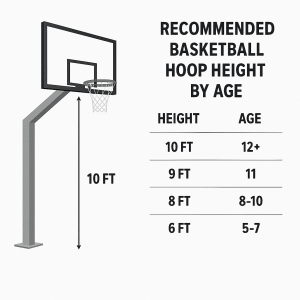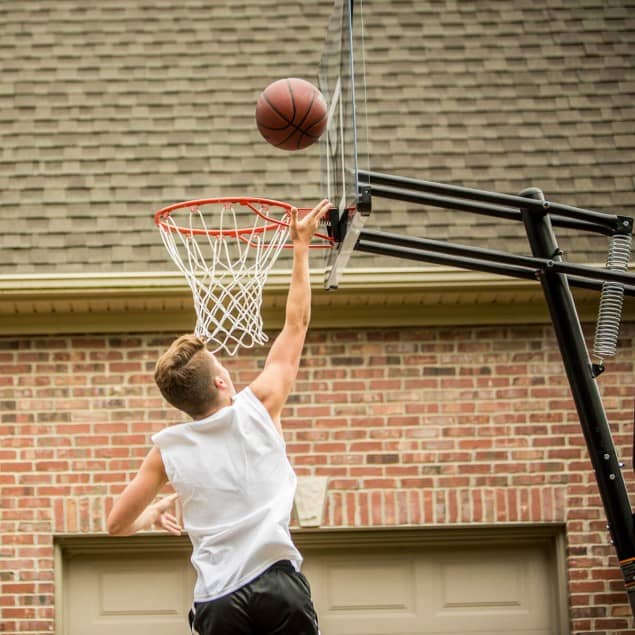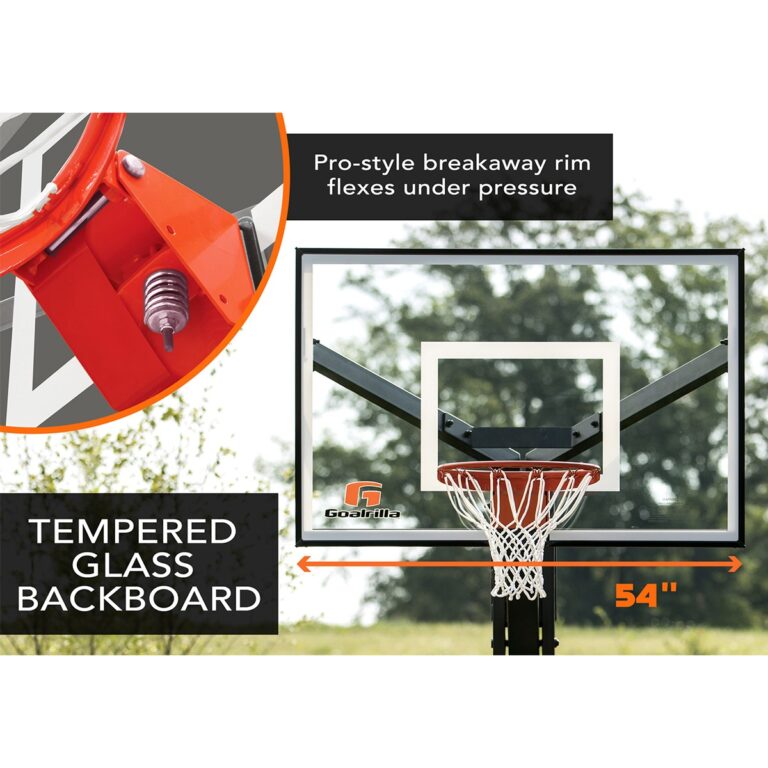How High Is a Basketball Hoop?
How High Is a Basketball Hoop? Everything You Need to Know
Wondering how high is a basketball hoop—and whether your kids can actually reach it? Whether you’re setting up in a driveway or coaching in a school game, knowing the correct hoop height makes all the difference. From toddlers to teens, this guide breaks it down clearly.
Standard Basketball Hoop Height (It Hasn’t Changed Since 1891)
Believe it or not, the regulation hoop height hasn’t budged in over 130 years. It all started in 1891 when Dr. James Naismith invented the sport of basketball. He nailed a pair of peach baskets to a railing in a YMCA gym in Massachusetts. That railing? Exactly 10 feet (3.05 meters) off the ground. It worked, and the height stuck.
Today, that same 10-foot standard is used across:
NBA and WNBA games
NCAA college basketball
FIBA international play
High school competitions
Senior club games in Ireland
This 10-foot height applies to all regulation basketball hoops, whether they’re mounted on a gym wall, attached to a portable base, or part of a freestanding unit in a driveway.
What About Kids and Beginner Players?
Here’s the thing: not everyone should be shooting at a 10-foot rim right away. In fact, starting kids off with a regulation-height hoop can do more harm than good. It makes the game frustrating and can lead to poor shooting form.
That’s why most parents and coaches opt for adjustable basketball hoops—something we at Pro Fitness Supplies offer in a wide variety. These systems let you lower the hoop to suit the player’s age and skill level, which encourages better technique and more fun.
A general guide for hoop height by age:
Ages 5–7: 6 feet (1.83m)
Ages 8–10: 8 feet (2.44m)
Ages 11–12: 9 feet (2.74m)
Ages 13+: 10 feet (3.05m)
Of course, these aren’t hard rules. If your child is confident and tall for their age, you might move up a level. Likewise, if they’re just getting started, there’s no harm in going lower.
We recommend choosing a hoop system that lets you adjust the height easily without needing tools. Our adjustable models are perfect for growing families and youth coaches alike. Check out our full basketball hoops collection for options that fit every space and skill level.
Choosing the Right Hoop Height: Why It Matters
Getting the hoop height right isn’t just about convenience—it shapes how young players learn the game. A rim that’s too high can turn shooting practice into a frustrating chore, disrupt shooting mechanics, and even discourage repeated play. Meanwhile, a height that matches the player’s arm reach and strength fosters confidence, better form, and more consistent improvement.
Adjustable Hoops: The Smart Investment
At Pro Fitness Supplies, our adjustable models let you tweak the height seamlessly—typically through a simple crank or lever system—so one hoop can support players from age 6 to 16+.
Here’s a quick breakdown of recommended heights by age:
Recommended Hoop Height by Age
| Age Range | Hoop Height | Why It Works |
|---|---|---|
| 5–7 | 6 ft / 1.8 m | Matches arm reach and builds early coordination |
| 8–10 | 8 ft / 2.4 m | Encourages proper shooting mechanics without overreaching |
| 11–12 | 9 ft / 2.7 m | Challenges players while still being accessible |
| 13+ | 10 ft / 3.05 m | Prepares young players for regulation‑level competition |
(Visual: Height-by‑age chart — see below)

This setup keeps the game fun while laying a solid foundation for growth.
Common Mistakes When Setting Up a Basketball Hoop (And How to Avoid Them)
Whether you’re a parent assembling a hoop for your driveway or a coach prepping a court for youth games, a few common errors can seriously affect how well your hoop performs—and how enjoyable the game is.
1. Setting the Rim Too High for the Age Group
This is one of the biggest pitfalls we see. Many first-time buyers assume the goal should always be 10 feet, but as we’ve outlined earlier, that’s too high for most kids. A 9-year-old trying to shoot at regulation height is more likely to throw the ball awkwardly than build good shooting habits.
➡️ Tip: Stick to the recommended height range for your child’s age. Use our handy graphic above as a reference, and check out our adjustable basketball hoop collection to find models that grow with your player.
2. Using a Low-Quality or Wobbly Base
If the base of your hoop isn’t properly weighted—or worse, if it’s made with thin plastic—it can become unstable. This not only affects gameplay but can also pose a safety hazard.
➡️ Tip: Choose a base that allows you to fill it with water or sand for added stability. Many of our portable basketball systems include reinforced bases designed for outdoor use.
3. Overlooking Backboard Size and Material
For younger players or casual games, backboard size might not seem important—but it actually makes a huge difference in how shots rebound and how satisfying the game feels. A too-small backboard limits layup practice and bank shots, frustrating more experienced players.
➡️ Tip: We recommend a backboard size of 48–72 inches depending on the space available. Tempered glass offers the best bounce for serious play, but acrylic is more durable for families.
4. Improper Installation or Mounting Height
If you’re wall-mounting or installing an in-ground unit, even a few inches too high or low can throw everything off. The hoop must be measured from the floor to the top of the rim, not the backboard.
➡️ Tip: Use a measuring tape to confirm height accuracy during setup. And if you’re not confident with tools, our installation expertise can handle that for you.
FAQs
1. Why is a basketball hoop set at 10 feet?
The iconic 10-foot rim height traces back to Dr. James Naismith’s first game in 1891. Hanging peach baskets from a railing exactly 10 feet off the ground at the YMCA in Springfield, Massachusetts, set the standard. It wasn’t chosen for athletic advantage—but the simplicity stuck. Today, that same 10-foot regulation height is used across professional, high school, college, and international play.
2. Can I lower a regulation hoop for younger players?
Absolutely. Many portable or in-ground hoops offer adjustable heights from 6 ft to 10 ft, making it easy to adapt the game as kids grow. This helps maintain proper shooting form, keep confidence high, and make the game more enjoyable for younger players. Choose a hoop with a smooth crank, notched system, or lever adjuster for safer, tool-free height changes.
3. How do I measure the hoop height accurately?
Always measure from the floor to the top of the rim, not the backboard. Use a reliable tape measure, preferably by marking a fixed reference point on the ground. If adjusting mid-season, recheck the height—especially after garage storage or cold snaps—to ensure it’s still set correctly for your player’s age group.
4. Is diameter the same for junior and regulation hoops?
Regulation hoops have an 18-inch (46 cm) diameter. Junior hoops may come with a smaller ring, but this doesn’t drastically affect scoring ease, since youth basketballs are also smaller. When shopping, confirm whether the hoop is standard size—or labeled as ‘youth’ or ‘junior’ to avoid confusion.
5. At what age should players transition to 10 feet?
Most players transition smoothly by 13–14 years old, but it’s less about age and more about readiness. If a 12-year-old displays good shooting form and hits regularly at 9 ft, it’s okay to move up. Trainers recommend increasing height gradually to preserve technique and prevent injury.
6. How does backboard size affect the game?
Backboard size matters more than most people realize. A full-sized board (72″×42″) provides better rebound angles, especially for bank shots and layups. Smaller boards (e.g. 48″) may be fine for small spaces, but may limit advanced practice. Select based on your space, budget, and how serious the players are.

